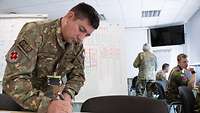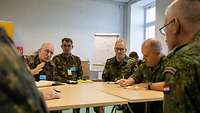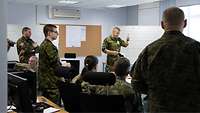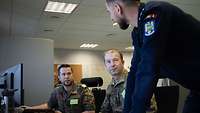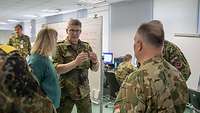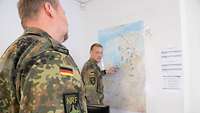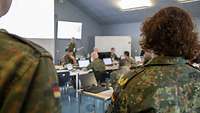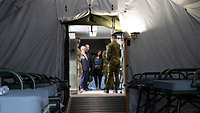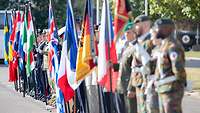CAMOContinuing Airworthiness Management Organisation 2023: Patient Flow Management – Multinational and Multidimensional
CAMOContinuing Airworthiness Management Organisation 2023: Patient Flow Management – Multinational and Multidimensional
- Date:
- Place:
- Europe
- Reading time:
- 3 MIN
During exercise Casualty Movement 2023 in Tartu, Estonia, the medical services of NATONorth Atlantic Treaty Organization and the EUEuropean Union train medical care in case of an attack. More than 200 participants from 18 nations and several NATONorth Atlantic Treaty Organization-Headquarters scrutinize the processes of patient flow management on Alliance territory. A scenario such as this one has not been exercised in detail for over 20 years.
The simulations centre of the Estonian Military Academy resembles an ant hill – bowing over maps and computer screens, soldiers clad in different uniforms are deep in discussion. Together, they continuously develop an overview of the situation and generate decision proposals. Their goal: To evacuate a great number of casualties from the combat zone back to their corresponding home countries. However, not a single vehicle moves during this exercise, instead small tokens on the map do symbolize emergency vehicles, blood bottles or oxygen. “In a simulation game like this, internationally known as Wargaming, we can play scenarios through that otherwise would be very hard to enact,” explains Lieutenant Colonel Andreas G., leader of the planning team at the Multinational Medical Coordination Centre/European Medical Command (MMCCMultinational Medical Coordination Centre/EMCEuropean Medical Command), the idea behind the exercise. “This way, we gain practically the same training effects as with letting real ambulances and their crews drive around while having a better opportunity to test and scrutinize processes and procedures.”
The wargame simulating medical care during the military defence of NATONorth Atlantic Treaty Organization territory after an attack is running altogether for a full four days. Especially the synchronisation between large scale casualty evacuation and other troop movements by air, land and sea is a highly complex task that needs to be trained regularly. Through the exercise Casualty Move 2023 the Multinational Medical Coordination Centre/European Medical Command (MMCCMultinational Medical Coordination Centre/EMCEuropean Medical Command) and the Estonian Military Academy together create the necessary circumstances to achieve just this.
Planning Close to Reality
Representatives from all strata of the military hierarchy – ranging from the divisional level up to the highest strategic tiers of NATONorth Atlantic Treaty Organization – will take part in this exercise, which will be conducted this year for third time. Germany will send soldiers from its Logistics School of the Bundeswehr, the Central Medical Command of the Bundeswehr and the Navy Command. Lieutenant Colonel G. , his team and the MMCCMultinational Medical Coordination Centre/EMCEuropean Medical Command have been preparing this exercise for over a year. It was not an easy task as the staff officer had to experience: “The Russian attack has raised a new conscience about problems within NATONorth Atlantic Treaty Organization’s nations and has set things in motion. Therefore, we faced the challenge to integrate current events into our exercise design.” Simultaneously, each nation’s interest to send soldiers from their medical service branches to participate in this exercise grew.
SHAPESupreme Headquarters Allied Powers Europe, as strategic-operative headquarters of NATONorth Atlantic Treaty Organization, tasked us to implement their Initial Patient Flow Management Guidelines in this exercise for the first time. Here it was of upmost importance to analyze and synchronise the processes in detail. “For us this meant to remain flexible during the planning and to stay in constant exchange with NATONorth Atlantic Treaty Organization headquarters to anticipate developments and adapt the exercise accordingly,” adds the 56-year-old staff officer. The experience drawn from this exercise is meant to finalize the guidelines in the upcoming months.
3 Questions to Brigadier General Dr. Stefan Kowitz
Director of the Multinational Medical Coordination Centre/European Medical Command
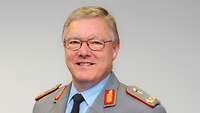
How does the exercise contribute to NATONorth Atlantic Treaty Organization’s defence?

The MMCCMultinational Medical Coordination Centre/EMCEuropean Medical Command aims to accomplish two different objectives: For once, it is to train our medical personnel to prepare for the defence of the Alliance. Our soldiers within the medical services of EUEuropean Union and NATONorth Atlantic Treaty Organization have to be able to care for and coordinate a high influx of patients, or casualties, in case the Alliance needs to be defended. Considering the large distances within the Alliance’s territory, take, for example, the line from the Russo-Finnish border down to Portugal, this is a coordinative task not to be underestimated, which necessitates a close civil-military cooperation.
What knowledge from Russia’s illegal invasion of Ukraine has already been incorporated into the exercise?

The war in Ukraine shows that internationally accepted rules and laws are being ignored by Russia. Despite displaying the protection symbol of the Red Cross, for example, there have been more than 700 recorded Russian attacks on medical facilities and their staff during the past twelve months. This kind of development has to be kept in mind during our planning operations. Apart from that, the success of the Ukrainian forces shows that a well performing medical service can bolster morale and increase combat prowess. This is why we need durable and combat ready medical services in NATONorth Atlantic Treaty Organization and the EUEuropean Union.
Additionally, we perceive high casualty numbers in Ukraine in a short span of time. Therefore, we have to come up with a solution on how to evacuate a high number of casualties from the combat zone. This is why, within the medical services, we are already discussing several options, such as hospital trains, hospital coaches, or hospital trains to be prepared and readied. Through this exercise we are able to analyse what abilities will be required by going through the necessary procedures and processes on a conceptual level.


